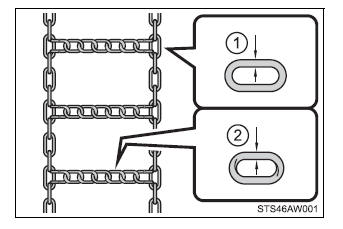Carry out the necessary preparations and inspections before
driving the vehicle in winter. Always drive the vehicle in a
manner
appropriate to the prevailing weather conditions.
Preparation for winter
Before driving the vehicle
Perform the following according to the driving conditions:
When driving the vehicle
Accelerate the vehicle slowly, keep a safe distance between you
and
the vehicle ahead, and drive at a reduced speed suitable to road
conditions.
When parking the vehicle
*: The shift lever will be locked if it is attempted to be
shifted from P to any
other position without depressing the brake pedal. If the shift
lever can be
shifted from P, there may be a problem with the shift lock system.
Have the
vehicle inspected by your Toyota dealer immediately.
Refueling (Flex-fuel vehicles)
Observe the following precautions when switching fuels, in order
to
maintain starting and driving performance.
- Do not change fuels when the fuel level is 1/4 or less.
- Always add at least 2.6 gal. (10 L) of fuel.
- After filling up with fuel, warm up the engine or drive the
vehicle for
at least 5 minutes or 7 miles (11 km).
- Do not accelerate rapidly immediately after refueling.
Selecting tire chains
Use the correct tire chain size when mounting the tire chains.
Chain size is regulated for each tire size.
- Side chain
(0.2 in. [5 mm] in diameter)
- Cross chain
(0.25 in. [6.3 mm] in diameter)

Regulations on the use of tire chains
Regulations regarding the use of tire chains vary depending on location
and type of road. Always check local regulations before installing
chains.
■Tire chain installation
Observe the following precautions when installing and removing
chains:
- Install and remove tire chains in a safe location.
- Install tire chains on the rear tires. Do not install tire
chains on the front tires.
- Install tire chains on rear tires as tightly as possible.
Retighten chains after
driving 1/4 - 1/2 mile (0.5 - 1.0 km).
- Install tire chains following the instructions provided with
the tire chains.
| WARNING ■Driving with snow tires
Observe the following precautions to reduce the risk of
accidents.
Failure to do so may result in a loss of vehicle control and
cause death or
serious injury.
- Use tires of the specified size.
- Maintain the recommended level of air pressure.
- Do not drive in excess of 75 mph (120 km/h),
regardless of the type of
snow tires being used.
- Use snow tires on all, not just some wheels.
- 4WD models: Do not mix tires of different makes,
models, tread patterns
or treadwear.
■Driving with tire chains
Observe the following precautions to reduce the risk of
accidents.
Failure to do so may result in the vehicle being unable to
be driven safely,
and may cause death or serious injury.
- Do not drive in excess of the speed limit specified
for the tire chains being
used, or 30 mph (50 km/h), whichever is lower.
- Avoid driving on bumpy road surfaces or over
potholes.
- Avoid sudden acceleration, abrupt steering, sudden
braking and shifting
operations that cause sudden engine braking.
- Slow down sufficiently before entering a curve to
ensure that vehicle control
is maintained.
|
| NOTICE ■Repairing or replacing snow tires
Request repairs or replacement of snow tires from Toyota
dealers or legitimate
tire retailers.
This is because the removal and attachment of snow tires
affects the operation
of the tire pressure warning valves and transmitters.
■Fitting tire chains
The tire pressure warning valves and transmitters may not
function correctly
when tire chains are fitted. |
|